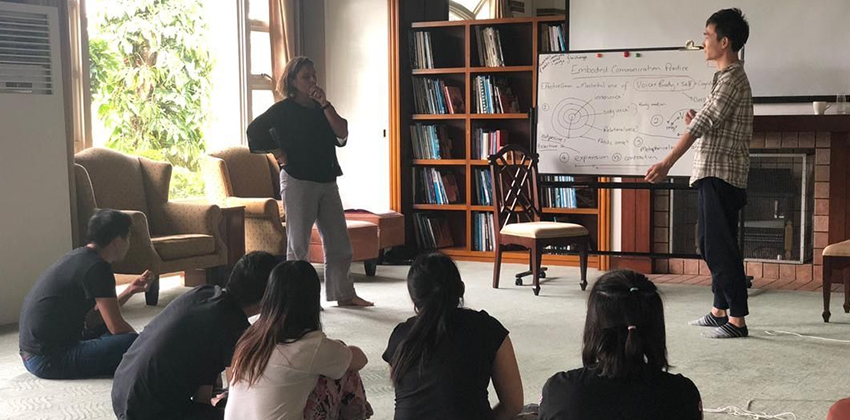Our voice is a key aspect of our vocational success and plays an important role in company culture. In the career development and business context, Voice Movement Therapy offers a unique approach to soft skills development, teaching effective and embodied communication, deepening emotional intelligence, and balancing the lived experience of the work environment with the individual’s sense of self and life goals.
Voice Movement Therapy practitioners work one-on-one with individuals who desire support in developing their careers and business relationships. Practitioners also work with companies that identify individuals, teams, or groups who may need voice coaching, communication skills development, motivation, confidence building, creative problem solving, and/or support during change and conflict resolution.
Companies are made up of individuals, each with their own personal narrative and history. Much of what Voice Movement Therapy offers is relevant to the business and career context. VMT takes an inside-out approach: practitioners help clients to firstly connect with their own internal experience of Self, from a psychological, embodied, and expressive perspective, and then to find and create bridges from this inner world to the outside world of relationships, team, and company.
Coaching Individuals
A number of VMT practitioners offer their services in an executive coaching capacity. VMT helps leaders and others reach their career goals by deepening their awareness of self and developing their authentic voice, within the company and the world at large. VMT practitioners support clients in finding and establishing groundedness, confidence, the ability to be assertive and maintain boundaries, and in aligning personal desires and career objectives.
By unpacking the nuances of work relationships and emotional triggers, VMT helps individuals shift blocks and dissolve patterns that may hold them back from reaching their full potential.
“The process of change is immediate and dynamic and the benefits have extended into my personal and business life.”
– Client testimonial
Mastering Communication
Voice Movement Therapy’s unique approach to communication training and voice coaching is applicable to everything from auditorium presentations to one-to-one conversations. VMT helps integrate the verbal, vocal, body language, postural, spatial, and energy dynamics of effective communication. Effective voice production and breathing, along with an understanding of tone, pitch, voice projection, and performance energy, are all key components of the VMT way of working (for more on voice coaching, see Vocal Pedagogy & Performance).
Employee Training, Development & Care
Working in collaboration with Human Resources departments, Voice Movement Therapy practitioners offer an embodied, dynamic, and impactful way of up-skilling employees. The VMT approach helps to better manage stress, anxiety, depression, and relationships across all levels of an organization.
VMT can be offered to individuals or implemented within groups to improve motivation levels, build teams, resolve conflicts, nurture multiculturalism and diversity, address aspects of gender inequality, and as a women’s empowerment program. In cases of redundancy/retrenchment and/or company restructuring, VMT practitioners provide support and grounding before, during, or after organizational change.

